Mark Sisson's Blog, page 225
April 20, 2016
8 Ayurvedic Herbs That Actually Work
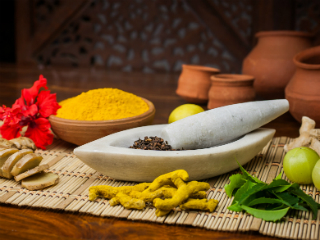 With so many time-tested treatment modalities out there, some which are thousands of years old, people are pretty curious as to whether some of the natural tips and recommendations penned in ancient literature are still effective today. Conventional medical wisdom assumes all that ancient medicine is just nonsense and superstition, that until a hundred years ago every health practitioner and patient lived under a massive collective delusion. If they got anything right it was through dumb luck, and today’s pharmaceutical companies have long since mined it for useful drugs and therapies. Could they all be useless? Whereas some older treatments have gone the way of the dodo in light of scientific scrutiny, many endure. In today’s post, I’ll subject the ancient world of Ayurvedic herbs to that same scientific scrutiny.
With so many time-tested treatment modalities out there, some which are thousands of years old, people are pretty curious as to whether some of the natural tips and recommendations penned in ancient literature are still effective today. Conventional medical wisdom assumes all that ancient medicine is just nonsense and superstition, that until a hundred years ago every health practitioner and patient lived under a massive collective delusion. If they got anything right it was through dumb luck, and today’s pharmaceutical companies have long since mined it for useful drugs and therapies. Could they all be useless? Whereas some older treatments have gone the way of the dodo in light of scientific scrutiny, many endure. In today’s post, I’ll subject the ancient world of Ayurvedic herbs to that same scientific scrutiny.
First transmitted through oral traditions and later through writings, Ayurveda dates back to at least 5000 BCE. That’s one long placebo effect. Let’s what the human studies have to say about some of these herbs.
1. Turmeric
Everyone and their vegan mother loves turmeric and knows how good it’s supposed to be for you. They may not be able to tell you what it actually does, but they know it’s good. Ayurveda knows, though. They’ve known for thousands of years that it’s anti-inflammatory enough to sometimes replace pain meds. It can reduce depression symptoms, even in patients with major clinical depression. It shows neuroprotective efficacy against animal models of Alzheimer’s disease, epilepsy, and other major neurological disorders. And it’s delicious. Pair with black pepper to make it even more effective.
2. Ashwagandha
The grandfather of Ayurvedic herbs, ashwagandha promotes a healthy response to stress. Stress is a major problem in the modern world. Everyone agrees. The big problem isn’t the thing causing the stress but how we respond to it. You can try reframing stress in your mind or learning to be less judgmental and reactionary and more present. You can also take the grandfather of Ayurvedic herbs, ashwagandha. Ashwagandha is an adaptogen, meaning it promotes a healthy stress response. Stress happens and you can’t avoid it. Ayurveda acknowledges this and offers ashwagandha as an ally to handle it. Whether it’s the negative impact on fertility and sex hormone production, the response to resistance training, or the spike in cortisol and anxiety, ashwagandha helps reduce the negative effects of stress on our health and happiness. It basically makes oxidative stress less bad.
3. Bacopa monnieri
Bacopa monnieri enjoys attention from the techie crowd for its beneficial and considerable effects on memory, but they weren’t the first to discover its nootropic qualities; for thousands of years Ayurvedic healers have been prescribing it for improved mental health and cognition. Whether you’re a senior citizen suffering from memory impairment, an older person who’s otherwise healthy, or even a young adult with no complaints, bacopa monnieri can increase your focus and working memory.
4. Holy basil
Make pesto from this and someone’s liable to get lucky, at least according to traditional Ayurvedic herbalists who used holy basil as a powerful aphrodisiac. In rabbits, holy basil is a potent testosterone booster (while decreasing sperm count). In humans, the sexual effects haven’t been tested or confirmed. What have been confirmed are the boosts to immune function and blood glucose control and reductions in anxiety and depressive symptoms.
That said, a friend of mine swears by holy basil for testosterone and libido boosting. Here’s how he takes it:
Tablespoon of dried holy basil leaves (also commonly available at Indian grocery stores).
Teaspoon of coconut oil.
8 ounces of water.
Bring all three ingredients to a simmer for five minutes, cover, and let sit for another 5. Strain out the leaves and drink.
5. Tribulus
Tribulus terrestris has gained notoriety among bodybuilders for its apparent ability to increase testosterone. Actually, though, the evidence for a T effect in humans is nonexistent. It does seem to boost erection rigidity and sexual well being, possibly by increasing androgen receptor density and thus androgen activity in the brain.
6. Gotu Kola
Gotu Kola sounds like a weird Pepsi knock-off, but it’s a potent herb with strong evidence for efficacy against a number of conditions. First and foremost, gotu kola is a must-try for patients with chronic venous insufficiency. The herb improves the swelling, microcirculation problems, and blood flow issues that accompany CVI. It may also increase alertness in older adults, reduce anxiety, and induce calmness in the face of acoustic surprises or jump scares (so take it before a scary movie and appear extra tough).
7. Boswellia serrata
Some actually classify Boswella serrata as a “phytopharmaceutical,” it’s so effective against inflammation, particularly joint inflammation. In osteoarthritis of the knee, Boswellia serrata reduces joint stiffness and pain and improves all other symptoms. In a placebo controlled trial of asthmatic patients, taking boswellia serrata for 6 weeks reduced symptoms. There’s even a single case study of a woman who eliminated a brain tumor that had spread from her breast using just Boswellia serrata.
8. Black cumin
Not to be confused with regular old (but still awesome) cumin, black cumin is more medicinal than culinary. It’s a broad-spectrum antimicrobial, effective even against antibiotic resistant bacteria. According to a review on its pharmacological effects, black cumin may improve hemoglobin levels, increase respiration, lower blood pressure, and improve lipids. It’s also been shown to reduce inflammation. In obese men, black cumin had remarkable benefits to subjective well-being that were not seen in the placebo group, including the elimination of complaints of hunger, fatigue, sleeplessness, forgetfulness, poor libido, pain, and general weakness. Another placebo-controlled study found that black cumin seed oil was effective against rheumatoid arthritis.
The effects of individual herbs are compelling enough, but Ayurveda traditionally prescribes combinations of herbs that ostensibly have synergistic effects. When subjected to clinical trials, many of these combinations show efficacy against conditions like Alzheimer’s dementia, knee osteoarthritis (some may even reduce cartilage degradation), rheumatoid arthritis, and excess inflammation. Not bad, eh?
That’s just a small taste of the more notable Ayurvedic herbs. Covering the many dozens more (and the hundreds of permutations of each) is beyond the scope of this post. But these are some of the highlights.
What about you guys? Any experience (for better or worse) with Ayurvedic herbs? Let me know in the comments below.
Prefer listening to reading? Get an audio recording of this blog post, and subscribe to the Primal Blueprint Podcast on iTunes for instant access to all past, present and future episodes here.
Not Sure What to Eat? Get the Primal Blueprint Meal Plan for Shopping Lists and Recipes Delivered Directly to Your Inbox Each Week. Now Available as an App!



April 19, 2016
Do Foam Rollers Really Work?
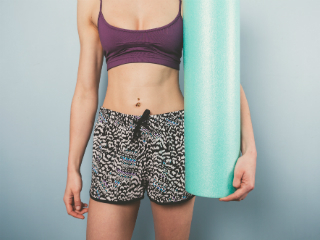 I own a foam roller. Every fitness facility I’ve visited in the last three years has hosted a large arsenal of foam rollers, lacrosse balls, and other instruments of fascial torture. The CrossFitter community has 2.3 per capita. I hear K-Starr sleeps on a bed made of lacrosse balls with foam rollers for pillows. Everyone and their grandma has one. I’m not even joking; I saw a group of track-suited seniors doing some kind of a synchronized foam rolling routine in the park recently. The things are everywhere. And you can certainly spend an inordinate amount of time rolling around on the things, causing all sorts of painful sensations that should, in theory, help you. But does it really help?
I own a foam roller. Every fitness facility I’ve visited in the last three years has hosted a large arsenal of foam rollers, lacrosse balls, and other instruments of fascial torture. The CrossFitter community has 2.3 per capita. I hear K-Starr sleeps on a bed made of lacrosse balls with foam rollers for pillows. Everyone and their grandma has one. I’m not even joking; I saw a group of track-suited seniors doing some kind of a synchronized foam rolling routine in the park recently. The things are everywhere. And you can certainly spend an inordinate amount of time rolling around on the things, causing all sorts of painful sensations that should, in theory, help you. But does it really help?
As I mentioned earlier, I have one. I’ve used it and, I think, benefited from it. But it hurts. It’s pretty much the most unpleasant thing you can do. Not just because of the pain, but also the tedium. It had better be worth the trouble.
What does the science say?
What foam rolling seems to do really well is increase range of motion without harming performance.
Foam rolling the calves works better than stretching the calves before a workout, increasing ankle range of motion (very important for squats and other athletic movements) without impeding performance. Stretching increased ankle range of motion slightly more, but it also lowered performance; foam rolling increased performance.
Several other studies have found foam rolling to improve range of motion at the hip and knee without hurting performance.
Performed post workout, foam rolling may reduce delayed onset muscle soreness (DOMS) and the associated hit to performance (hard to move when you’re sore all over!), making it an effective if moderate recovery tool.
After a heavy squat workout, subjects did 20 minutes of foam rolling immediately, 24 hours, and 48 hours post-workout. Four weeks later, they did the same workout without any foam rolling afterwards. Foam rolling decreased DOMS and mitigated the performance decrements.
Another study had similar results, finding that foam rolling after a squat workout reduced soreness and improved vertical jump and muscle activation.
Should you foam roll everything? Is it worth getting into those ridiculously contrived positions in order to hit some small ribbon of fascia hidden between limbs? Should you foam roll your face?
Hamstrings see mixed results. Several studies find a lack of effect. In a recent one, foam rolling had no additional effect on hamstring range of motion or tightness in people with tight hamstrings when added to regular static stretching. Another found that 2 minutes of foam rolling was insufficient to improve hamstring tightness or increase knee extension range. Yet another study found that foam rolling was effective at increasing hamstring flexibility, comparable to contract-relax stretching.
In my experience, the hamstring isn’t a great candidate. I rarely feel any tender spots on my hamstrings with the roller. Using a lacrosse ball produces some tender spots, but the foam roller might just offer too diffuse a stimulus to work. One study had decent results using a roller-massager on the hamstrings, which is kind of “rolling pin” for your tissues that lets you really bear down.
Lately, folks that I respect (like Angelo Delacruz of Vitamoves) have been saying not to foam roll the IT band. That the real cause of IT band issues is in the surrounding musculature, particularly the glutes. This makes sense. The IT band is a tough and fibrous swathe of connective tissue that connects to and supports the most powerful muscle group on the body—the hip-glute-hamstring-quad complex. Rolling around on some foam isn’t going to do much to such an impressive piece of physiological real estate.
Yet I’ve experienced direct benefits to knee pain after foam rolling my IT band for a few minutes. I’ll do a set of squats, feel a sharp pain in my knee, suspect the IT band is inhibiting something, foam roll the band and focus on the tenderest spots, and squat again pain free. Am I fooling myself? Maybe. But I’ll take it.
It’s pretty clear that foam rolling doesn’t do what a lot of proponents say it does:
Foam rolling doesn’t “stretch” or lengthen the tissue. You can’t squeeze out any extra length like you’re rolling out some dough.
Foam rolling doesn’t remove mechanic adhesions. To do that, to “peel apart” gummed up tissues, you’d need shear stress, not compression.
Some people think foam rolling opens a window of opportunity for better movement. You roll a tender spot. For whatever reason, your nervous system has determined that this is the proper, safe range of motion for you. Foam rolling clears that out, giving you a short opportunity to establish a new safe pattern. More than physical adhesions, it’s removing neuromuscular blocks and harmful patterns. You reset the system and reprogram it.
Others think foam rolling relies upon diffuse noxious inhibitory control (DNIC). DNIC is how the brain dampens pain. Usually, pain increases survivability; it occurs to warn you against danger. If something hurts, your body’s trying to stop you from hurting yourself more seriously. But sometimes the brain “decides” that maintaining the pain is more trouble than it’s worth or more dangerous. If a solider loses a limb in battle, he might not feel much pain until he’s able to get to safety. If he felt the full pain of the lost limb, he’d be unable to save himself. That’s DNIC—the brain determining that reduced pain is beneficial to survival and less dangerous than prolonging it. In causing momentary pain that we regard as beneficial and necessary, foam rolling may “tell” the brain to turn the pain off.
Whatever the mechanism(s), it can work.
Foam rolling before your workout is better for range of motion and performance, especially if you take advantage of the open “movement window” and move. Foam roll, do some mobility drills, then get to training.
Foam rolling after your workout can reduce post-workout soreness and performance declinations. Studies show that this can reduce post workout soreness, increase range of motion (without reducing power or strength output, like pre-workout static stretching does).
The majority of the research deals with standard foam rollers, but any self-myofascial release tool (lacrosse balls either individual or taped-together, roller-massagers, Rumble Rollers, your own knobby elbow) should produce similar effects.
Don’t foam roll the site of the pain. If your knee hurts, don’t foam roll the knee. Foam roll the tissues above and below it.
Foam rolling is not enough. You have to foam roll and move and mobilize. Foam roll and train. Foam rolling is an excellent tool on the belt, not the only one.
In some respects, foam rolling only treats the symptoms. If your incorrect movement patterns, your life stressors, and your lack of regular movement are causing the tissue issues, foam rolling will help you feel and perform better but won’t “fix” the underlying problem. Unless you fix the problems causing the pain and mobility issues, you’ll have to keep rolling.
The research is equivocal. Sometimes it works, sometimes it doesn’t, and despite some promising hypotheses, no one is quite sure why. That doesn’t mean you can’t benefit from foam rolling. Based on the research, thousands of anecdotes, and my own experience, I’d say it’s worth a shot.
Thanks for reading, everyone. What’s your experience been with foam rolling? Useful, placebo, pointless, harmful? Let’s hear all about it down below!
Like This Blog Post? Subscribe to the Mark's Daily Apple Newsletter and Get 10 eBooks and More Delivered to Your Inbox for FREE



April 18, 2016
Dear Mark: Just Outside of Goal Weight, Skipping Breakfast and Coffee, and Quark
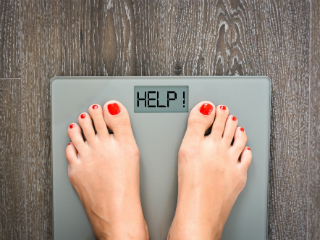 For today’s edition of Dear Mark, I’m answering four questions. First up, I discuss what to do—and really, what not to do—as you approach your goal weight but keep coming up short. Second, why do breakfast skippers also tend to be the biggest coffee drinkers around? Is it just correlation or is there a causative explanation lurking within? And finally, what’s the deal with the cultured dairy product known as quark? Is it a worthwhile addition? Is it safe, given its decidedly neolithic origins?
For today’s edition of Dear Mark, I’m answering four questions. First up, I discuss what to do—and really, what not to do—as you approach your goal weight but keep coming up short. Second, why do breakfast skippers also tend to be the biggest coffee drinkers around? Is it just correlation or is there a causative explanation lurking within? And finally, what’s the deal with the cultured dairy product known as quark? Is it a worthwhile addition? Is it safe, given its decidedly neolithic origins?
Let’s go:
Hi Mark,
I’ve been trying to lose fat for over 3 years and haven’t reached my goal yet. I have reached close to my goal but the weight is creeping back.
I’m not overweight. I’m healthy. I should be happy for what I have and I am. However, I can’t let go my hope that I want to look better. I have decent energy throughout the day and I think I have pretty good metabolism for my age (46). However, recently, I feel that the more I try the more I gain fat. I haven’t weighted for several months, so I don’t know how much I gained though. I’ve been trying tabata exercise 3-4 times a week and a quick kettle bell swing 3 times a week. I also go to the gym classes for fun. I am so stuck and desperate. Should I just be happy for my current body (again, not overweight, skinnier upper body with a little flab around thighs, buttocks and love handles.)
Thanks!
“I’m not overweight. I’m healthy.” Stop right there. You’ve got your answer.
Besides,”a little” body fat centered around the lower body (hips, butt, thighs) is a sign of health in women. Lower body fat tends to be higher in omega-3s like DHA, so that when you’re constructing a baby, you’ve got plenty of substrate to build the brain. You may not be trying to have any kids, but on a base physiological level the ability to do so is indicative of your health—your fitness. It’s the belly and trunk fat that’s problematic and should be avoided.
Here’s what I’d do. Chill out on the training. 3-4 days a week of tabata is rough. Tabata training isn’t just something you do. It’s really hard and really demanding. Cut that to 1-2 days a week. Heck, do one tabata day and one sprinting day.
Then you do “quick kettlebell swings” 3 times a week? It all depends on what you mean by “quick.” Kettlebell training falls into the anaerobic category, just like tabata training. You know, the kind where your lungs and muscles burn and you crave carbohydrates to replenish lost glycogen? You’re looking at 6-7 days of training, unless you’re doing double days which is arguably even harder to recover from.
What’s this about gym classes for fun? C’mon. That’s way too much.
Instead of just the tabata and kettlebell swings and extra gym days sprinkled on top, drop some of it and replace some with slow strength work and lots of walking. You are walking, right?
Trying to mechanically burn calories through added output usually doesn’t work very well. It leads to overreach and overtraining, especially since it usually coincides with calorie reduction (you know, to lose more weight). And we have direct evidence that it’s not working very well for you: “the more I try the more I gain fat.” Exactly!
Take it easier. Lift 1-2 days a week. Sprint/tabata 1-2 days a week. Walk every day if you can. Get your sleep. Do things you enjoy (and the gym doesn’t count!).
I’m curious how many breakfast skippers out there are coffee drinkers?
Whenever I quit coffee, I end up developing an appetite for breakfast after a few days. I’m thinking maybe my body is being deprived of needed nutrients when I have coffee instead. Also, my water intake goes up when I don’t have coffee–maybe it’s depressing the thirst mechanism?
Mark, maybe we need to run an experiment with the group? Everyone grab your Grok combat gear before coffee disappears from your pantry.
I write this, of course, with a cup of “my precious” sitting beside me. No breakfast for me today lol.
I’d guess that most breakfast skippers drink coffee. One major side effect of caffeine is appetite suppression. See, caffeine raises adrenaline, which liberates body fat and increases fat available for energy. It also increases insulin resistance temporarily to allow for optimal fat burning, which is why a coffee and pastry make a fattening—if delicious—pairing. It’s also why coffee obviates the need for outside energy; you’re actually consuming your own body fat when you drink coffee.
It’s not necessarily a terrible thing, though, when you consider why this occurs. When caffeine increases adrenaline, it also increases lipolysis—the liberation of fatty acids from body fat. The increased sense of energy you get from coffee is partly caused by the increased availability of energy in the form of free fatty acids. Of course, an increase in free fatty acids shooting around your body causes a subsequent—and necessary—drop in insulin sensitivity to allow you to actually burn the fat. It all makes perfect sense when you consider the entire picture, but it sounds pretty scary out of context.
If you’re going to eat breakfast alongside coffee and you have weight to lose, stick to lower-carb choices. Tucking into a big plate of flapjacks alongside a pot of coffee works for lumberjacks preparing for a day of insulin-sensitizing sawing, hauling, and lifting, but not your average lumbersexual about to hunker down in front of his computer all day.
This is why coffee can exacerbate stress-related issues. When you’re not sleeping well or you’re on that wired but tired state of mind because you’re juggling too many things at once, coffee beckons but boosts many of the stress hormones you’re already bathing in.
Hey Mark,
I’ve been reading for years and I’m a big fan of everything you and your team does. Since moving to Germany for school, I’ve found it somewhat more difficult to find some primal snacks while so much involves bread of some kind. I tried yogurt, but found that I got some acne and maybe a little sluggishness. Recently, one of my friends turned me onto quark, a full fat, thick, creamy yogurt with a closer nutritional profile to cottage cheese. I don’t get the acne flair ups or stomach issues I did with yogurt. I’m curious about your opinion of the bioavailability of the macronutrient content and whether you’d advise for or against making it a regular addition to my diet. Thanks for everything and I look forward to hearing from you!
Best,
Brian
I know these sciencey-sounding names are unappetizing, but we’re constantly ingesting quarks. As a fundamental buildingblock of matter, the quark is unavoidable. I don’t care if you’re eating kale, bison, carrots, or protein powder: you’re also eating quark. Don’t believe me? Okay. Well, you love hadrons, don’t you? Everyone does. They’re delicious. You’ve probably got a few in your mouth right now. Hadrons are actually composite particles made up entirely of quarks. So there’s really no escaping it.
Quarks aren’t “healthy” or “unhealthy.” There’s no good or bad. Sure, the quarks you get from fast food french fries pale in comparison to the quarks found in a Big Ass Salad, but you can’t ascribe morality to a subatomic particle. It’s all just a choice.
Oh, wait. Quark is something different. It’s a strange kind of almost yogurt. Regular yogurt is inoculated with thermophilic (heat-loving) bacteria. Quark is like buttermilk in that it’s inoculated with mesophilic (room temperature-preferring) bacteria. In fact, traditional quark is made with buttermilk cultures. This makes it less tangy.
This guy knows his quark (PDF), but he’s a little quirky (see what I did there?). Don’t mind his obsession with a blend of quark, fish liver/flax/hemp oil, and champagne as a magical elixir that cures nearly every degenerative disease. Or, I suppose, mind it. I’m just not responsible for what happens when you try to serve it instead of mimosas at your next brunch.
Let’s address your specific questions.
Bioavailability of the nutrients: high. As an animal product, quark’s nutrients will be readily absorbable. Many plant food nutrients must be converted into animal food nutrients before an animal (like you) can take advantage. If the conversion pathway is disrupted or inhibited, you might not be getting all the nutrients that show up in nutritional databases. Animal food nutrients come in the pre-formed package. Easy to assimilate.
Lack of acne flareups and other immune symptoms: awesome and telling. Your personal response to quark doesn’t mean this guy or that guy will have a similar reaction, but it’s damned telling about whether you should eat yogurt or quark. Eat the quark. Dairy is good if you can eat it.
Thanks for reading, everyone. I’d love to hear from you down below.
Does trying to do too much derail your weight loss efforts? Are you a coffee drinker and breakfast skipper, too? Love quark? Hate it? How about quarks?
Have a great week.




April 17, 2016
Weekend Link Love – Edition 396
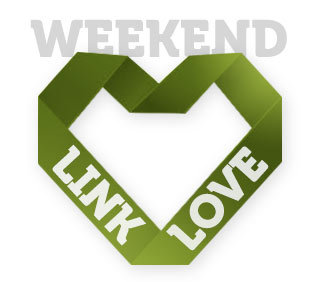 I was on Lewis Howes’ The School of Greatness podcast and had a great time chatting about Primal living, training, and entrepreneurship. Give it a listen.
I was on Lewis Howes’ The School of Greatness podcast and had a great time chatting about Primal living, training, and entrepreneurship. Give it a listen.
Research of the Week
40 years ago, a landmark study seemed to show that lowering cholesterol by replacing saturated fat with polyunsaturated fat reduced heart disease. Today, hidden data now revealed shows the opposite: that replacing butter with vegetable oil lowered cholesterol and increased heart disease.
Some people are completely healthy despite carrying genes that are supposed to saddle them with crippling diseases.
When doctors go on strike, mortality drops.
Due to immune mismatches, human women probably couldn’t carry Neanderthal hybrid males to term.
New Primal Blueprint Podcasts

Episode 115: Matt Whitmore and Keris Marsden: Host Brad Kearns chats with Matt and Keris about their new book Fitter Food, Second Helping, the role of fat, carbs, and ketones in training, how fitness nutrition has changed in recent years, and much more.
Each week, select Mark’s Daily Apple blog posts are prepared as Primal Blueprint Podcasts. Need to catch up on reading, but don’t have the time? Prefer to listen to articles while on the go? Check out the new blog post podcasts below, and subscribe to the Primal Blueprint Podcast here so you never miss an episode.
Why Breakfast Isn’t the Most Important Meal of the Day (For Everyone)
Interesting Blog Posts
Are we the only intelligent animals on earth? (Warning: you’ll want to tickle a chimp toddler after reading this.)
Urban raccoons are getting really smart. “Uber for dumpsters” next?
Media, Schmedia
This is your brain on (psychedelic) drugs.
“The sustained contraction of the margarine market” is hurting Unilever.
Never mind about that “PUFA worse for heart disease” study I mentioned earlier. Mustachioed observationalist Walter Willett says the new analysis of the old data is just “an interesting historical footnote” that is “irrelevant to current dietary recommendations.”
Everything Else
Cephalopods just wanna be free, man.
Michelle Tam (of Nom Nom Paleo) on umami.
The plane that might alleviate jet lag.
A cool new FitBit feature tracks “steps per hour.”
How the healthiest old guy on the planet stays so healthy and supports his world-record sprint performances: “I avoid sugar and eat lots of meat, especially fat. I’ve been on a fat trip lately. Fat! Piles of fat.”
Hey, how about that! 45% carb diets are apparently low-carb, according to South African authorities.
Recipe Corner
German apple (paleo) pancakes are pretty much the best thing.
Orange dijon chicken is way better than that junk from Panda Express.
Time Capsule
One year ago (Apr 20 – Apr 26)
Essential Oils: Separating Fact From Fiction – What’s this smelly stuff good for?
How to Get Your (Health) Groove Back – What do you do when you get off track?
Comment of the Week
Why do people with smaller waists like to keep their houses colder?
– Well done, Aaron.




April 16, 2016
Southwest Drumsticks with PRIMAL KITCHEN™ Chipotle Lime Mayo
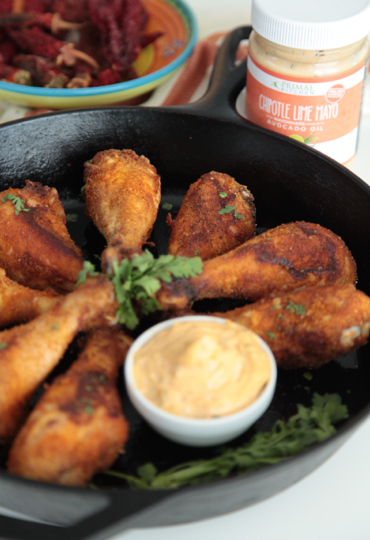
Who can resist meat with a built-in handle? No utensils needed for drumsticks, just a stack of napkins or the willingness to lick your fingers clean. Which is a pleasure, when they’re covered with chicken fat and zesty Southwest spices.
Southwest drumsticks are coated in coconut flour and spices, baked until brown and crispy, then dunked repeatedly in spicy chipotle mayo. It’s an easy dinner or deliciously convenient lunch, so consider cooking a batch specifically to grab cold out of the refrigerator.
The chipotle lime mayo is already made for you in the Primal Kitchen. PRIMAL KITCHEN™ Chipotle Lime Mayo is dairy, soy and canola oil free with no sugar or artificial ingredients. This flavored mayo has just the right amount of heat, plus a smoky chipotle flavor. It’s the perfect sidekick for these drumsticks. Once you have a jar of the mayo in your refrigerator, how else can you use this addictive (and convenient) condiment? Fish, salmon cakes, steak and chilaquiles immediately come to mind.
Servings: 4
Time in the Kitchen: 50 minutes
Ingredients:

8 drumsticks, patted dry
2 tablespoons coconut flour (13 g)
1 1/2 teaspoons salt (7 ml)
1 teaspoon chili powder (5 ml)
1/2 teaspoon ground cumin (2.5 ml)
1/2 teaspoon smoked paprika (2.5 ml)
1/4 teaspoon garlic powder (a pinch)
1/4 teaspoon black pepper or cayenne (a pinch)
Instructions:
Preheat oven to 425°F/218°C.
In a small bowl, mix together the coconut flour, salt, chili powder, cumin, smoked paprika, garlic powder and pepper.
Put the drumsticks in a large sealable bag and pour in the seasoning mix. Shake and toss the bag until every drumstick is well coated in seasoning.
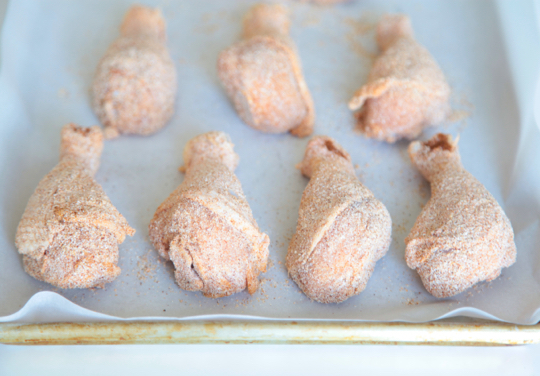
Butter or lightly oil a baking dish, rimmed baking sheet or cast iron skillet. Put the drumsticks in the baking dish and cook for 20 minutes. Flip the drumsticks over and cook for about 20 minutes more, until the outside is browned and the inside temperature reads at least 165°F/74°C on a digital thermometer.
Serve the drumsticks warm or cold with PRIMAL KITCHEN™ Chipotle Lime Mayo for dipping.
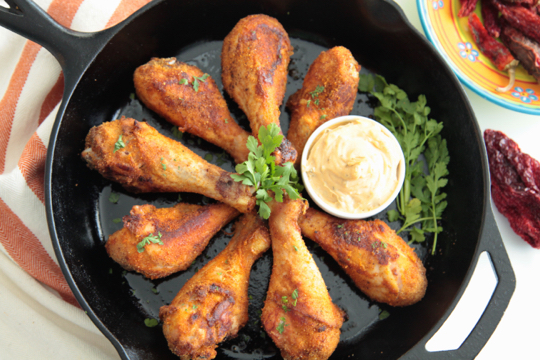
Not Sure What to Eat? Get the Primal Blueprint Meal Plan for Shopping Lists and Recipes Delivered Directly to Your Inbox Each Week. Now Available as an App!



April 15, 2016
70 Pounds Lighter and Medication-Free: How Going Primal Changed My Life
It’s Friday, everyone! And that means another Primal Blueprint Real Life Story from a Mark’s Daily Apple reader. If you have your own success story and would like to share it with me and the Mark’s Daily Apple community please contact me here. I’ll continue to publish these each Friday as long as they keep coming in. Thank you for reading!
 I’ve been the chef/owner of a couple of restaurants for the past 23 years. When I started in the biz I was kind of like a kid in a candy store! I gained on average about nine pounds a year for 10 years and found myself weighing in at an impressive 317 lbs! I was told by my then doctor to “do” something or bad things were going to happen! I was pre-diabetic and borderline high blood pressure. No specifics on diet or exercise or anything were mentioned. I was left on my own to lose weight and get better.
I’ve been the chef/owner of a couple of restaurants for the past 23 years. When I started in the biz I was kind of like a kid in a candy store! I gained on average about nine pounds a year for 10 years and found myself weighing in at an impressive 317 lbs! I was told by my then doctor to “do” something or bad things were going to happen! I was pre-diabetic and borderline high blood pressure. No specifics on diet or exercise or anything were mentioned. I was left on my own to lose weight and get better.
So I went on a no starch diet and joined a health club! I’d go to the health club between lunch and dinner shifts. I lost 30 lbs and got in aerobic shape through lots of hours on the treadmill and elliptical machines. Emphasis on the word treadmill. Not much fun involved at all. So of course, I gained some weight back and stopped the health club. My weight yo yo’d for the next ten years, I became Type II Diabetic and officially had high blood pressure.
In July of 2014 I weighed in at around 296 pounds, was on a Type II diabetes medication called Glipizide, taking a pill called Losartan for my high blood pressure, and was just prescribed a pill called Omeprazole for my constant queasy stomach and acid reflux. I didn’t eat bacon anymore and couldn’t even stand the smell of it! So I took all these pills and still felt terrible! But I had good blood pressure readings, my blood sugar was “under control” and I wasn’t so queasy anymore. So from the medical community’s standpoint, I was “cured”, see ya, and that couldn’t have been further from the truth! What was the root cause of all my problems? I took it upon myself to do some research.
I zeroed in on fixing my gut first, the thought being that everything starts in the gut! I read some books by Dr. Alejandro Junger and proceeded to sign up for his 21-Day Clean Gut Repair program. I did a protein shake for breakfast, ate a salad with some protein for lunch and had a second shake for dinner. No gluten, no sugar, no dairy, no alcohol and no caffeine! There were a lot of other no’s too, but these were the major ones. Lots of supplements including digestive enzymes, probiotics, liver support and blood sugar support taken at each “meal.” By the middle of the second week I felt great! Stopped the Omeprazole! By the middle of the third week I asked the coaches “what do I do next, the program’s almost over! What do I do for the rest of my life?” One of them said “check out Mark’s Daily Apple, go Primal.”
 I did and I did! Best move I ever made (besides marrying my wife of course)! Bought the books, signed up on Marksdailyapple.com. And started reading. The food is great and just by eating Primal, I started losing weight! I couldn’t do the PEMs, sprints, not even jumping jacks to warm up! Just too out of shape and too much stuff jiggling around. It hurt! I really thought I’d never be able to run again. And I was just 62! But the weight kept coming off and little by little I started getting in better physical shape. Then I joined the online 21-Day Primal Blueprint Challenge that runs on Vimify.com every month. That really helped. The online community there is so supportive! I continued to lose weight, my blood sugar was under control and my high blood pressure was coming down! I run, I sprint, I play! I became a mentor for the online challenges then in October of 2015 I took the online courses to become a Primal Blueprint Certified Expert!
I did and I did! Best move I ever made (besides marrying my wife of course)! Bought the books, signed up on Marksdailyapple.com. And started reading. The food is great and just by eating Primal, I started losing weight! I couldn’t do the PEMs, sprints, not even jumping jacks to warm up! Just too out of shape and too much stuff jiggling around. It hurt! I really thought I’d never be able to run again. And I was just 62! But the weight kept coming off and little by little I started getting in better physical shape. Then I joined the online 21-Day Primal Blueprint Challenge that runs on Vimify.com every month. That really helped. The online community there is so supportive! I continued to lose weight, my blood sugar was under control and my high blood pressure was coming down! I run, I sprint, I play! I became a mentor for the online challenges then in October of 2015 I took the online courses to become a Primal Blueprint Certified Expert!
The results are in, but they are not final. I still have some way to go! But I’ve lost 70 lbs, I’m off ALL my meds, my blood pressure is normal and my A1C is going down. My doctor is impressed! I’m back to eating bacon! I have a website called EatBaconGetHealthy.com. I do Primal specials in my restaurant, Harry’s Hideaway in Cornville, Arizona. I’ve developed a online 21-Day Primal Food Challenge that’s going to start running on Vimify in May 2016 with recipes and videos. Life is good! And I owe it all to Mark Sisson and The Primal Blueprint! You are a genius Mark! Unlike the other “diets” I’ve been on, this truly is a way of life and something I’ll be doing for the rest of my (hopefully longer) life!


Thanks again, Mark!
Harry Olson
P.S. This week was a momentous occasion! I went to see my doctor. My wife has been trying to get our insurance premiums lowered given my recent weight loss and exercise activity. So here’s how my doctor summed up my visit: “You are no longer diagnosed obese. You are no longer Type II diabetic. Your blood pressure is perfect. Your cholesterol numbers are that of a 20 year old. And you are officially off all medications!” I’m getting a little choked up writing that. Why this Primal lifestyle is not mainstream is crazy!




We’re Hiring PRIMAL KITCHEN™ Brand Ambassadors in Southern California!
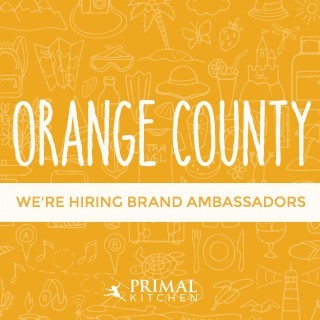 Calling all PRIMAL KITCHEN™ enthusiasts! Do you love PRIMAL KITCHEN™ products? Does the idea of educating others on the benefits of wholesome, healthy, delicious ingredients pique your interest? Looking for some fun, flexible, part-time work? Then today is your lucky day! We’re hiring part-time employees in the Southern California area. If you (or someone you know) meet the requirements from the list below, and you’re looking for work with lots of control over your schedule, please apply by filling out the application here and emailing your resume to sierra@primalkitchen.com. Go over our Brand Ambassador checklist and see if you’re a match. If you are, then you might be snagging one of the hottest positions in SoCal!
Calling all PRIMAL KITCHEN™ enthusiasts! Do you love PRIMAL KITCHEN™ products? Does the idea of educating others on the benefits of wholesome, healthy, delicious ingredients pique your interest? Looking for some fun, flexible, part-time work? Then today is your lucky day! We’re hiring part-time employees in the Southern California area. If you (or someone you know) meet the requirements from the list below, and you’re looking for work with lots of control over your schedule, please apply by filling out the application here and emailing your resume to sierra@primalkitchen.com. Go over our Brand Ambassador checklist and see if you’re a match. If you are, then you might be snagging one of the hottest positions in SoCal!
Requirements:
You love hanging out in Whole Foods or your local natural grocery store
You have an outgoing personality and you’re incredibly charming and fun
You live a Primal lifestyle
You have a general understanding of why avocado oil is the best oil—and you’re not afraid to educate shoppers
You like to talk
You have wheels
You live in Southern California, preferably Orange County or Los Angeles (Westside or South Bay)
You have a smartphone (for recording information from your demo)
Are you ready to be a Brand Ambassador? Apply here.




April 14, 2016
Why Hobbies Are an Important Part of Primal Living
 “So, what do you do?” We’ve heard the question (and likely asked it) a million times over when meeting people. It’s the standard line for small talk, but it’s always rubbed me the wrong way. Admittedly, the question itself isn’t the problem. I personally love hearing what people are up to, but the assumption behind the question—“What do you do to make a living?”—often won’t get you to the real stories. For me, I’d rather hear about how people feed their passions than how they pay their bills. For many if not most people, the two don’t go hand in hand. I think those passions might be in shorter supply these days, and it’s a sad turn of events for the collective creativity as well as personal well-being.
“So, what do you do?” We’ve heard the question (and likely asked it) a million times over when meeting people. It’s the standard line for small talk, but it’s always rubbed me the wrong way. Admittedly, the question itself isn’t the problem. I personally love hearing what people are up to, but the assumption behind the question—“What do you do to make a living?”—often won’t get you to the real stories. For me, I’d rather hear about how people feed their passions than how they pay their bills. For many if not most people, the two don’t go hand in hand. I think those passions might be in shorter supply these days, and it’s a sad turn of events for the collective creativity as well as personal well-being.
With extended work hours and commutes as well as the prevalence of technological distractions, many of us are devoting fewer hours to hobbies. We fulfill the requirements of the day, but what do we end up doing for fun beyond the passive entertainments of the television and computer? And when we do take advantage and do something we enjoy, do we take the time to cultivate our interest? Do we allow ourselves to delve into an activity many times over, to develop a skill for pure enjoyment and mastery’s sake as opposed to practical gain?
Even if we can’t recall the last time we devoted our time to anything resembling a hobby, we can likely recall our parents or grandparents at their pastimes—cooking, creating, tinkering. Maybe your mother sewed clothes for enjoyment or honed a photography talent. Perhaps your dad tended an impressive garden or built furniture. Perhaps a grandparent left behind a collection of poems, quilts, watercolors or birding sketches. If you’re like me, it’s a primary framework for the many memories you carry of them. You can picture them involved in that activity—maybe even teaching you something about it. Their tools and creations filled the house or garage. Neighbors or extended family called on them as the source for whatever their hobby produced, whether it was the best barbecued meats or expert clock repair.
The prevalence of hobbies in past generations wasn’t just a response to the old Puritanical saying, “Idle hands are the devil’s workshop.” (Okay, maybe for a few folks…) Still, the inclination toward creative pastimes has long been ingrained in us—the product of our evolution over millennia.
Our species didn’t progress by sheer accident, but by random (and then selected for) cognitive jumps and simultaneous cultural innovation. “Emergent creativity,” a product of both these influences, was a boon for humanity. This wasn’t so much about any artistic talent of a particular person, but about the historical creativity that reflected a widespread, often co-occurring surge toward increasing inventiveness on both social and technological levels.
Yey culturally driven change wasn’t all a “necessity is the mother of invention,” “goal-directed behavior” enterprise. The conditions for creativity require experimentation and discovery, which happens largely by accident. A boy discovers that a certain plant leaves color on his fingers, and he later applies it to an animal skin. Another discovers a different rock for sharpening spearheads. A girl plays with a stiff reed and finds she can make different notes with varying perforations. People found interests—and, importantly for our species’ saga, kept at them.
Before archeologists can “find” and mark new developments in human history, they need to find evidence of them happening repeatedly. When relics show themselves in patterns, and a novel form is documented, they’re pinned to the time period related to the particular dig where they were found. But in actuality, many items were likely long in use before the date of the site they were found.
New inventions weren’t made by one person and then circulated over the globe. People everywhere stumbled upon and honed the same inventions by virtue of the same creative process. The process is the key. It might be unusual to imagine, but (once the critical cognitive leaps had occurred) we literally played and tinkered our way into cultural and technological advancement.
Today we live with that legacy, given that those innovators are our ancestors. While we may not have the same motivations toward survival or considerable hours of leisure our Grok families did, a good Primal lifestyle still calls to live out that dimension of our nature through our own play and hobby work—and for good reason. Those who engage regularly in self-selected leisure activities report more happiness and life satisfaction and less negative stress and depressive symptoms. Additionally, and maybe more significantly, they demonstrated lower heart rates, with the positive effect lasting for hours afterward. The “flow” state these hobbies commonly induce offers a potent and ongoing antidote to the physical and mental ravages of stress.
Older people may have more to gain, especially physically and cognitively. A Mayo Clinic study showed older adults who participated in hobbies such as reading and crafting were 30-50% less likely to suffer from mild cognitive impairment than those who didn’t regularly engage in leisure activities. The key here may be the building and maintaining of “cognitive reserves” through the connections these kinds of activities strengthen over time. The more we engage in hobbies that challenge us, the more resilient our brains may become.
Last week The New York Times highlighted enrichment programs for seniors that seek to harness the power of the arts for cognitive and physical health. The programs, which track their own results, reveal positive impacts as varied as decreased blood pressure and depression, fewer falls and doctor visits, and enhanced mood and well-being.
Beyond these suggestions from health-related research, there are experts who likewise push for a hobby comeback. One career coach shares that hobbies have helped her clients reduce stress, manage anger, and enhance work performance because of their potential to “improve…decision-making, creativity and confidence.”
Frankly, the modern hobby horse of specialization can backfire if we’re not investing ourselves in other ways outside our job sites. The best leaders I’ve worked with have not surprisingly been the most well-rounded. I find people who have outside interests to be more engaging communicators and more relaxed, self-possessed people. The less dependent you are on your job for your identity and fulfillment, the less desperate and intense you’ll likely be in the office and the more open to diverse opportunities.
Think back to the time before people assumed you were old enough to be working, the time when they asked you what you liked to do. What was your answer then, and what would it be now? That’s the question I’d argue we need to continue asking ourselves.
Thanks for reading, everyone. Share your thoughts on hobbies as an element of the good life and what your personal pastimes are. What do your leisure endeavors do for your sense of well-being? What opportunities and experiences have they opened to you? Have a great end to the week.
Prefer listening to reading? Get an audio recording of this blog post, and subscribe to the Primal Blueprint Podcast on iTunes for instant access to all past, present and future episodes here.




April 13, 2016
12 Surprising Things You Can Do With Avocado Oil
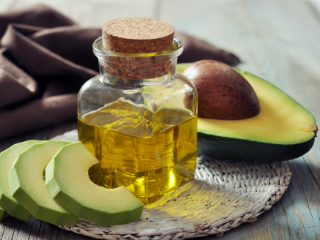 If it were up to me, I’d have a steady supply of perfect, ripe avocados on hand. They’d have no blemishes, no bruising, no weird soft spots, no stringy veins running through. Every avocado would be ripe and somehow manage to stand up to rough handling. They wouldn’t be watery or mushy—just creamy. Life would be good, and I’d probably retire and begin an all-avocado diet. But that’s not reality. Avocados are a crap shoot. They take forever to ripen. There’s usually something wrong. Half the time I have to cut out half the flesh just to approach edibility. And I say this living in the home state of the best avocados in the world.
If it were up to me, I’d have a steady supply of perfect, ripe avocados on hand. They’d have no blemishes, no bruising, no weird soft spots, no stringy veins running through. Every avocado would be ripe and somehow manage to stand up to rough handling. They wouldn’t be watery or mushy—just creamy. Life would be good, and I’d probably retire and begin an all-avocado diet. But that’s not reality. Avocados are a crap shoot. They take forever to ripen. There’s usually something wrong. Half the time I have to cut out half the flesh just to approach edibility. And I say this living in the home state of the best avocados in the world.
Enter avocado oil. No, it’s not quite the same as a plump avocado. No, you can’t make guacamole out of it, although some disgusting heathen has probably tried using gums and thickeners. For that it falls short of a plump avocado. But because first-press avocado oil—the kind I make—retains most of the fat-soluble nutrients, antioxidants, carotenoids, and chlorophylls found in the fruit, just like extra virgin olive oil retains olive nutrients, first-press avocado oil provides the power of the avocado in a compact, reliable, convenient, pourable package.
And it lets you do lots of cool things:
1. Make meals less inflammatory.
Adding half an avocado to a standard hamburger meal reduced the postprandial inflammatory response. Without the avocado, levels of the inflammatory cytokine IL-6 remained elevated 4 hours after the meal. With the avocado, IL-6 was unchanged.
2. Improve wound healing.
In animal models, adding topical avocado oil to a wound dressing greatly improved the wound’s healing rate, increased collagen synthesis, and reduced inflammation at the wound site.
3. Fry stuff (healthily).
Fried food of any kind shouldn’t be a staple. I don’t care how stable your oil is; fried food is a treat. But if you are going to fry, do it right. MUFA-rich avocado oil has the stability of olive oil without the prominent olive oil flavor. Don’t get me wrong: I love the taste of extra virgin olive oil. But the taste dominates anything you cook. If you’re trying to do a gluten-free southern fried chicken or any other fried dish that doesn’t mesh with EVOO, avocado oil is a subtler frying medium.
4. Actually absorb nutrients in your salad.
Salad is so healthy, right? Not without fat, and avocado fat is one of the best mediums for delivering highly-absorbable salad-based nutrients like carotenoids into circulation. It even improves your conversion of plant-based vitamin A precursors into retinol—real vitamin A that you can use.
5. Shave.
I’ve been shaving every day for 40 years. Yeah, yeah: Grok rocked a beard, but so what? They’re just too itchy and I’m not too worried about MRSA. I can’t get over the hump to where it starts feeling normal. Anyway, sometimes I’ll use about a quarter teaspoon of avocado oil rubbed into my face in lieu of shaving cream. While you don’t get the satisfying dichotomy between clean shaven skin and foam-bedecked skin, it does work just as well.
6. Make half-way decent mayo.
Apparently this works. I can’t vouch for it yet, but supposedly there’s a fair approximation of mayonnaise produced using avocado oil out there in the market. Sounds weird to me, to be honest (give me rancid soybean oil or nothing!). Stranger things have happened, though.
7. Remove makeup.
When I want to remove mascara and eyeliner, I always turn to avocado oil. It’s safe, it works, and if a little bit extra drips down my face, I can just eat it or hold my head over a bowl of lettuce and make a nice salad.
8. Moisturize skin.
Creams/lotions/balms/salves, shmeams/shmotions/shmalms/shmalves! Too much work to investigate the good ones. Once you find yourself looking up polysyllabic ingredients on EWG, that’s a sign to simplify. There’s no simpler way than slathering a single ingredient on your skin. Avocado oil, with its bounty of carotenoids, vitamin E, and healthy fat, is a great choice for maintaining skin health and moisture. An easy rule of thumb is if it’s safe and good to eat, it’s safe (and possibly beneficial) for your skin.
9. Improve psoriasis.
In subjects with chronic plaque psoriasis (where white crusts form on top of the skin sores), combination vitamin B12/avocado oil ointment was compared to the vitamin D3 analogue calcipotriol. Both treatments worked, with the calcipotriol working quicker but subsiding after 4 weeks and the avocado oil/B12 ointment working more slowly but consistently. Seeing as how vitamin B12 deficiency is involved in the etiology of plaque psoriasis, avocado oil alone may not work as well as the study results indicate.
10. Dress the greatest summer salad ever.
This one might sound odd. Just trust me. Make it. You need really good watermelon. Avoid the mealy ones grown in another country during the offseason. Find the best watermelon when they’re in season near you. Go to the farmer’s market and ask the watermelon guy to pick one out if you don’t know how.
Get some sheep feta. The real stuff, not cow feta. Greek or Israeli fetas tend to be my favorites.
Chop up a handful of fresh mint. Toss it all together, drizzle with avocado oil. Maybe a squeeze of lemon or lime. There: that’s it.
11. Add to baths.
Ancient Romans who could afford it would clean their bodies with olive oil and scrape it (and any dirt and dead skin) off using a strigil (a kind of spatula for removing body oil). They were awash in the stuff. If I could do that with avocado oil, I would. A couple glugs into the bath, though, is a nice compromise that gives the water a silky texture and leaves you moisturized, not pruny and dried out.
12. Improve the way your mitochondria function and respond to stress.
We don’t have data in humans, but in rats—even diabetic ones—dietary avocad12. oil reduces oxidative stress and restores mitochondrial function. This jibes with the evidence that excess linoleic acid (PUFA) is harmful to mitochondria, while oleic acid (MUFA) is beneficial. Avocado oil is very high in oleic acid, about equal to olive oil.
Until recently, avocado oil has been marginal, merely occupying a small niche in the market. I hope to change that. I think it deserves better standing. Don’t you?
Thanks for reading, everyone. Take care and let me know how you like to use avocado oil!




April 12, 2016
Why Breakfast Isn’t the Most Important Meal of the Day (For Everyone)
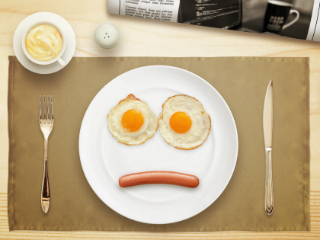 If you’ve been reading this blog for any amount of time, you know I’m always interested in exploring those time-tested bits of advice, those old wives’ tales, that folk wisdom handed down generation over generation because they’re often right, or at least contain a kernel of truth. And if a piece of conventional folk wisdom turns out to be wrong or misguided, understanding why it endured for so many years is a fun exercise and usually reveals other messages and truths. Today, I’m looking at the importance (or lack thereof) of breakfast. For years, you’ve heard how important breakfast is. Your grandma says it. Your doctor probably scolds you if you’re not eating it. We all grow up having this “fact”—breakfast is the most important meal of the day—drilled into our subconsciouses. Even the people who just don’t feel hungry in the morning feel guilty about it and compelled to stuff something into their craws.
If you’ve been reading this blog for any amount of time, you know I’m always interested in exploring those time-tested bits of advice, those old wives’ tales, that folk wisdom handed down generation over generation because they’re often right, or at least contain a kernel of truth. And if a piece of conventional folk wisdom turns out to be wrong or misguided, understanding why it endured for so many years is a fun exercise and usually reveals other messages and truths. Today, I’m looking at the importance (or lack thereof) of breakfast. For years, you’ve heard how important breakfast is. Your grandma says it. Your doctor probably scolds you if you’re not eating it. We all grow up having this “fact”—breakfast is the most important meal of the day—drilled into our subconsciouses. Even the people who just don’t feel hungry in the morning feel guilty about it and compelled to stuff something into their craws.
Is it right or wrong?
Before I begin, I’m a little biased. I follow a compressed eating window, from noon/1 to about 6 or 7 at night. On a typical day, I’ll wake up and grab a mug of coffee with a splash of heavy cream and a teaspoon of sugar. And that’s it until lunch, my biggest meal of the day. Since I’m such an effective fat burner, this schedule clearly works for me. I experience even-keeled energy on a consistent basis. My productivity is high, I’m happy with my physical performance and ability to recover, and I don’t stress over food because I’m just not hungry. It makes things easier overall. Plus, though solid research in humans is scant on this, I stick to a compressed eating window to promote autophagy (cellular maintenance) and hedge against aging and neurodegeneration (if those things ever come!). Based on what I’ve heard from thousands of readers, I’m not alone on this. But a single anecdote, or a collection of thousands, doesn’t prove much. We need to look deeper.
Well, what do the breakfast proponents actually claim? Let’s examine some of the claims and see what the evidence says.
Breakfast makes you lean, skipping breakfast makes you fat
The epidemiology of breakfast skipping certainly seems to suggest a connection between skipping breakfast and obesity:
In a cohort of Japanese adults, skipping breakfast was linked to greater body weight and waist size.
Among American young adults, breakfast skippers weigh more, have more abdominal obesity, and an elevated cardiometabolic risk profile.
In both white and black American teenage girls, eating breakfast is linked to higher calcium and fiber intakes and lower body weights.
But these are observational studies, and observational studies cannot establish causality.
So what’s going on here? A few things.
Unhealthy user bias: As breakfast skipping is widely considered to be unhealthy, breakfast skippers may be unhealthy in other areas. They eat more and exercise less, and they’re more likely to drink more alcohol and smoke more cigarettes. Iranian children, for example, who skip breakfast are heavier with larger waists than non-skippers, but they also eat more fast food, fruit juice, salty snacks, and sugary soda than their breakfast-eating counterparts, who favor fruits, vegetables, and milk. Unless you can establish that skipping breakfast causes these lifestyle differences, you can’t say that skipping breakfast plays a causal role.
Dieter bias: Breakfast skippers are likely to be actively dieting, and active dieters usually only diet because they have weight to lose.
The a priori effect: When you presume “breakfast is important” to be true, all your research and results must flow from that presumption.
And a few years ago, a group of researchers took a close look at the evidence other researchers were using to prove the “casual link” between obesity and breakfast skipping. They weren’t very impressed, finding that:
Most researchers suffered from confirmation bias, throwing out or disregarding evidence to the contrary and emphasizing evidence that supported their views. They favored observational studies showing a link and ignored the controlled trials showing no effect.
They used “casual terms” when discussing their work and the work of other scientists researching the breakfast/obesity question when no causality had been established.
Instead of observational studies, there are a couple intervention studies (where causality can be examined) worth examining.
In a study from the late 1990s, overweight women were randomized to either eat large breakfasts (with smaller dinners) or large dinners (with smaller breakfasts). Those in the large breakfast group lost the most weight, but they also lost the most lean mass. The large dinner group, who didn’t skip breakfast but ate a meager one, lost the most fat mass and preserved the most lean mass. Like I always ask, what kind of weight are you trying to lose—fat or muscle?
In 2014, researchers randomly divided a group of dieting adults into two groups. One group was told to eat breakfast, the other was told to skip it. After 16 weeks, weight loss was basically identical across both groups. Neither skipping breakfast nor eating it had any discernible or unique effect on weight loss.
Other studies have indicated that skipping breakfast may actually reduce the overall amount of calories a person eats throughout the day. A spontaneous reduction in calories eaten is generally a path to weight loss.
Breakfast gives you boundless energy
“Energy” is difficult to measure objectively. There’s no blood test for “chi” or “life force,” so we have to rely on subjective reports of things like “alertness” and extrapolate from related objective markers. Energy expenditure is a decent marker for how much energy you have. If you’re burning more energy, your body obviously has “enough” to spare. Another is blood glucose control. If your blood sugar takes a dive, that typically manifests as hunger and sleepiness.
“Breakfast” doesn’t tell us much. Some breakfasts will give you better energy than other types of breakfast. A higher protein, lower carb breakfast tends to increase energy expenditure and improve “postprandial wellness” (basically, how do you feel about life after eating this breakfast?). If you throw in some fat with the protein, you can even improve a type 2 diabetic’s glucose tolerance throughout the day, which corresponds to steadier energy levels.
Meanwhile, high-carb breakfasts do the opposite: they make people hungrier sooner, cause greater elevations in insulin and a subsequent drop in blood sugar at 3 to 4 hours after breakfast. The reduced satiety, heightened insulin spikes, and low blood sugar combine to make people “hangry,” sleepy, and susceptible to break room donuts to take the edge off.
It’s true that some studies find connections between skipping breakfast and low subjective alertness or cognitive or physical performance. But these studies are either observational, conducted using standard sugar-burning subjects (as opposed to fat-adapted subjects), or concern children and adolescents (a more energy-intensive subset of humanity for whom breakfast skipping is often nonconsensual, unnecessary, and counterproductive). And the ones that do find a positive relationship between teens, breakfast, and subsequent cognitive function find the greatest benefit from low-GI (read: low-carb, higher fat and protein) breakfasts.
Skipping breakfast destroys your metabolism
If skipping the occasional breakfast is enough to send you into starvation mode, surely all-out fasting for 72 hours will do the trick. Right? Except when healthy humans are told to fast for three days and their biomarkers are monitored, we find that the resting metabolic rate only drops by 8%. 8% is 8%, sure, but that’s a full 72 hours without food. Skipping breakfast doesn’t even compare.
Skipping breakfast makes you overeat
It does seem to make people overeat at lunch, but not enough to make up for the skipped breakfast. In one study of free-living adults, skipping breakfast led to earlier and bigger lunches. Despite the increased hunger and larger lunches, breakfast skippers still ate fewer calories per day than the breakfast eaters. This is consistent with earlier studies showing that breakfast skipping does not lead to compensatory food intake at lunch and dinner, and in fact may reduce calorie balance by over 400 per day. You might feel hungry enough to eat twice as much, but at the end of the day you end up in an energy deficit.
So, can everyone safely skip breakfast?
Not exactly.
If you’re eating a higher or moderate carb diet, breakfast may be the best time to get your carbs. Insulin sensitivity follows a circadian rhythm. Muscle insulin sensitivity is highest in the morning and lowest at night—meaning your muscles are primed to accept and store glucose as glycogen with minimal insulin input—so breakfast is a good time to eat some carbohydrates. Skipping breakfast and then eating a high-carb lunch exacerbates the insulin and blood sugar spike you’d normally get. Eating a carb-rich breakfast “preps” your body for the carb load at lunch.
Side note: The circadian sensitivity of carb tolerance can be overcome with training and physical activity, since exercise restores insulin sensitivity independent of circadian phase. So if you’re going to carb-up during a phase of circadian insulin resistance, make sure to train.
If you compete or train really hard in the morning, a small breakfast could be a good idea. On Sundays, when I play my big Ultimate Frisbee game, I’ll have a small breakfast with my coffee—usually a couple scoops of Primal Fuel mixed in water.
If you’re a child or adolescent, you should probably eat breakfast. You’re growing. And the observational studies finding links between breakfast skipping and overweight tend to focus on kids and teens. Just to be safe, eat something.
If you’re a type 2 diabetic eating a high-carb diet, you should eat breakfast (preferably egg-based). A recent study in diabetics found that skipping breakfast drastically increased the glucose spikes that occurred after lunch and dinner. However, lunch and dinner were high-carb and low-fat (20% fat, 54% carb, 26% protein, 700 calories each), which is a terrible combination for type 2 diabetics.
Side note: This presupposes the type 2 diabetic in question insists on eating a high-carb diet. When you give them healthier meals lower in carbs—salmon, nuts, leafy greens, olives, garlic, tomatoes, cucumbers, and a little bread—diabetics can actually skip breakfast and get more favorable glucose numbers at lunch. If you’re a Primal type 2 diabetic eating low-carb, high-fat meals, your meals won’t provoke those kinds of glucose spikes—breakfast or no breakfast.
If you’re a woman, you might do better with breakfast. In general, women function more poorly skipping meals. I’ve covered this before; skipping breakfast just doesn’t seem to work as well for women. That said, a slightly later breakfast—say, at 10 AM instead of 8 AM—may be a good compromise for women who want to try breakfast skipping.
All that said, there is one huge confounding variable the “breakfast is awesome” controlled trials never account for: meal timing entrainment. Almost everyone eats breakfast. The “normals,” at least. So the average study participant is a habitual breakfast eater whose body expects and likely functions best (at least for now) with regular breakfast intake. You get a group of them together, “starve” them, and you’ll see awful results. Huge insulin spikes, glucose crashes, fatigue, general malaise. It’s like fast tracking the low-carb flu, and it’s going to skew your results. People habituate to the eating schedules they follow. If you’re a natural breakfast skipper, skipping breakfast isn’t going to have the same effect on you.
In a recent study, the authors actually tested this, separating overweight women into habitual breakfast skippers and habitual breakfast eaters and then having them either skip breakfast or eat breakfast.
Breakfast eaters who skipped breakfast experienced way more hunger at lunch. They had worse blood lipids and their insulin skyrocketed. Breakfast skippers who skipped breakfast experienced none of these deleterious effects.
Breakfast eaters who ate breakfast were more satiated at lunch. They had better blood lipids and fairly normal insulin levels. Breakfast skippers who ate breakfast were just as hungry at lunch as normal; the extra meal couldn’t abate their regular lunch-time appetite.
As long as they stuck to their normal eating habits, they had normal responses.
What’s the big takeaway here?
If you’re the type who “never feels like breakfast,” keep skipping it. If it’s easy, don’t eat it. If you’re not hungry, don’t force yourself.
If you’re the type who wakes up ravenous, eat! Don’t skip it just because you read a study somewhere.
What do you think, folks? How do you respond to skipping breakfast?
Thanks for reading. Take care and be good.
Like This Blog Post? Subscribe to the Mark's Daily Apple Newsletter and Get 10 eBooks and More Delivered to Your Inbox for FREE



Mark Sisson's Blog
- Mark Sisson's profile
- 199 followers



